|
To get
your other machines to use the Internet across the LAN through
the Linux box you will have to follow the steps for the appropriate
Operating System:
-
Windows 95/98/Me
1. On
your Desktop right click on "Network Neighborhood"
and then left click "Properties", this will open
the "Network" window.
2. In
the "Network" window you want to highlight "TCP/IP"
by left clicking it once, then you need to click on the "Properties"
button.
3. When
the "TCP/IP Properties" window appears you want
to click the "IP Address" tab, which should already
be the default selected. You will need to left click the "Specify
an IP Address" radio button which will enable the two
boxes underneath it. Now you need to enter and IP Address
for this client machine (making sure not to use one already
in use by another machine) and the appropriate subnet mask.
For example:
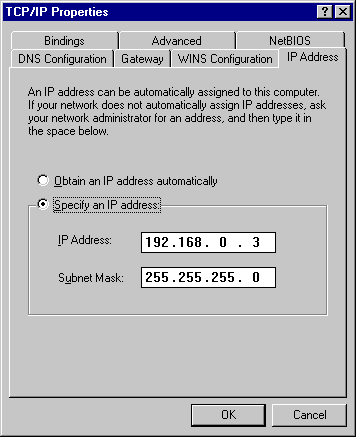
4. Next
you want to click the "Gateway" tab. In the "New
gateway" box type in the LAN IP Address of the Linux
box and then click the "Add" button. You should
end up with something like this example:
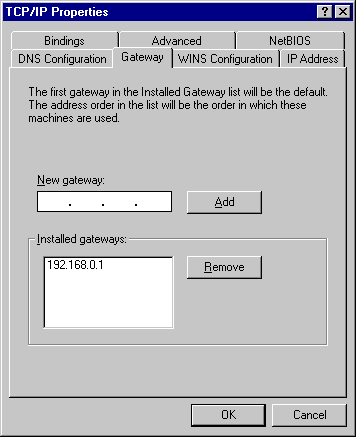
5. Now
you need to click the "DNS Configuration" tab. Firstly
you need to click the "Enable DNS" radio button,
then you must enter a Host (a home LAN doesn't use a domain
unless you have one registered), the host name should be the
client machine's name, i.e. if the computer name is "Familybox"
then the host should be "Familybox". Next you want
to add the DNS Address of the Optus@Home
servers, this is done by typing them one at a time into the
box just under "DNS Server Search Order" and clicking
"Add" after entering each address. You should end
up with a windows similar to this example:
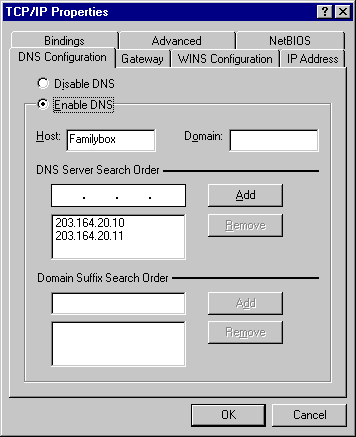
Once
you have entered all the details in just click on "OK"
and then "OK" again and your done.
-
Windows 2000/NT
1. On
your Desktop right click on "My Network Places"
and then left click "Properties", this will open
"Network and Dial-up Connections" folder.
2. In
this you want to right click on your "Local Area Network"
and then left click "Properties", this will bring
up all the details on your LAN interface card.
3. Highlight
"Internet Protocol (TCP/IP)" by left clicking it
once, then once again you want to left click the "Properties"
button which will bring up a new window.
4. The
new window titled "Internet Protocol (TCP/IP) Properties"
will appear and this is where you want to entire your settings,
similar to the snapshot below, with your IP address for your
client machine (making sure not to use one already in use
by another machine) and the appropriate subnet mask, the gateway
as the IP address of Linux box and the DNS servers as the
Optus@Home IP address of your
node (this make it slightly faster by putting all DNS requests
straight to them and bypassing your own DNS server on the
Linux server). If you know what your doing and want to make
some more changes (they aren't required) you can click on
"Advanced" and the more detailed options will appear
in a new window.
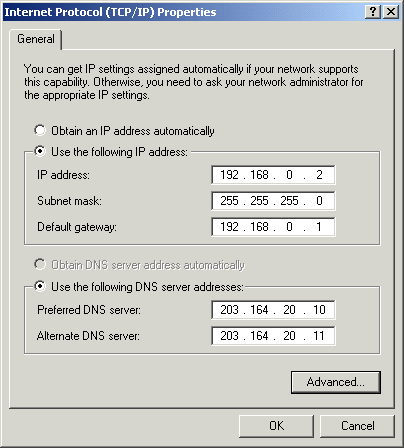
Once
you have entered all the details in just click on "OK"
and your done.
-
Macintosh
Setting
up a Macintosh is basically the same as above.
1. Open
the control panel from the Apple menu.
2. Open
the "TCP/IP" control panel. It should look like
this:
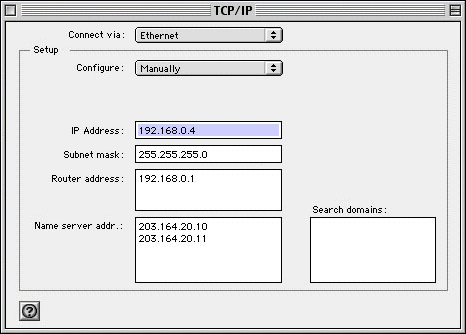
3. Select
"Manually" under the configuration method and give
the machine an IP address (making sure not to use one already
in use by another machine) and also enter the subnet mask.
4. The
router address is the same as the gateway address, so type
in the LAN IP address you gave to your Linux box.
5. Now
you want to add the DNS Address of the Optus@Home
servers, this is done by typing them one at a time into the
box "Name server addr.:"
|

